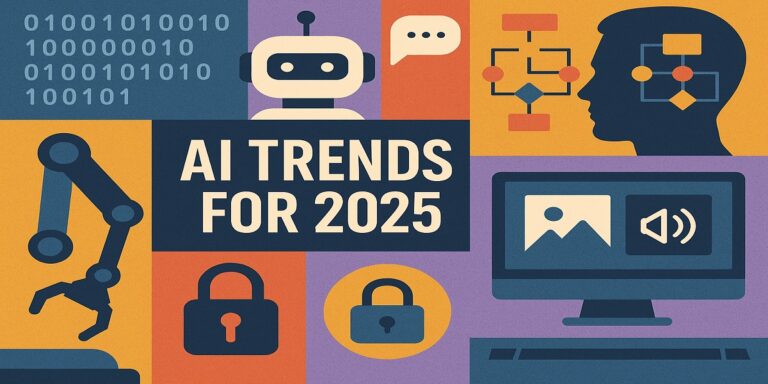Generative AI is at an impasse. It’s been more than 2 years after ChatGPT’s introduction and the initial optimism about the AI’s future is diminished by a realization of its shortcomings and the costs.
In 2025, the AI landscape is an example of this the complexity. Although excitement is still high especially in the emerging areas like the agentic AI and multimodal models, it’s also set to become a time with increasing difficulties.
Businesses are increasingly seeking tangible outcomes from the generative AI and not just early-stage prototypes. It’s not an easy task for a technology that’s typically costly, error-prone and prone to abuse. Regulators will have to be able to balance safety and innovation as well as keep up with a rapidly changing technology environment.
Here are the top eight AI trends to be aware of in 2025.
1. Hype can be replaced with more pragmatic strategies
Since 2022, there has an explosion of interest and creativity in the field of generative AI but the reality of its use isn’t always consistent. Businesses often face challenges in moving the generative AI projects whether they’re products for internal use or consumer-facing applications, from trial to production.
Although many businesses have looked into the possibilities of generative AI through proofs of concepts however, few have fully implemented it into their daily operations. In an September 2024 study Informa TechTarget’s Enterprise Strategy Group found that even though more than 90% of companies have grown their AI generative AI usage over the last year However, only 8% believed their efforts to be to be mature.
“The most surprising thing for me [in 2024] is actually the lack of adoption that we’re seeing,” stated Jen Stave, launch director for the Digital Data Design Institute at Harvard University. “When you look across businesses, companies are investing in AI. They’re building their own custom tools. They’re buying off-the-shelf enterprise versions of the large language models (LLMs). But there really hasn’t been this groundswell of adoption within companies.”
One of the reasons is the fact that AI has a different impact on jobs and roles. Companies are noticing the what Stave described as”the “jagged technological frontier,” in which AI increases productivity for specific jobs or employees, but reducing it for others. For instance, a junior analyst for instance, may be able to dramatically increase their productivity employing a program that hinders a more knowledgeable colleague.
“Managers don’t know where that line is, and employees don’t know where that line is,” Stave explained. “So, there’s a lot of uncertainty and experimentation.”
Despite the high levels of generated AI hype however, the fact that it is slow to adopt isn’t a surprise for anyone who is familiar with enterprise technology. In 2025, expect companies to work harder for tangible results from generative AI, including lower costs, demonstrable ROI and improvements in efficiency.
2. Generative AI goes beyond chatbots
When the majority of people encounter the term “generative AI“ and imagine tools such as ChatGPT or Claude that are powered by LLMs. The initial explorations of businesses also, tend to include the incorporation of LLMs into services and products using chat interfaces. However, as technology develops, AI developers, end customers and business users alike are looking to go beyond chatbots.
“People need to think more creatively about how to use these base tools and not just try to plop a chat window into everything,” said Eric Sydell, founder and CEO of Vero AI, an AI and analytics platform.
This change is part of an overall trend of creating software on top of LLMs instead of deploying chatbots as standalone applications. Transitioning away from chatbot interfaces and into applications that rely on LLMs at the back end to parse or summarize unstructured data may help to alleviate some of the problems that create the generative AI challenging to grow.
“[A chatbot] can help an individual be more effective … but it’s very one on one,” Sydell explained. “So, how do you scale that in an enterprise-grade way?”
In 2025, certain sectors in AI development are beginning to shift away from traditional text-based interfaces. The future of AI will be focused on multimodal models, such as the OpenAI’s video-to-text Sora as well as ElevenLabs’ AI voice generator that can handle non-text types of data like videos, audio and images.
“AI has become synonymous with large language models, but that’s just one type of AI,” Stave explained. “It’s this multimodal approach to AI [where] we’re going to start seeing some major technological advancements.”
robotics is another option to develop AI that extends beyond textual conversations in this instance interaction physically. Stave believes that the robotics’ base models could be more transformational than the emergence of generative AI.
“Think about all of the different ways we interact with the physical world,” she added. “I mean, the applications are just infinite.”
3. AI agents will be the next frontier for AI.
The second part of 2024 has witnessed an increase in interest in AI agent models that can take independent action. Tools such as Salesforce’s Agentforce are built to perform tasks autonomously designed for users in the business sector, such as managing workflows and managing routine tasks, such as scheduling and analysis of data.
Agentic AI is still in its infancy. Human control and direction remain crucial, and the range of actions that could be performed is typically narrowly defined. However, despite the limits, AI agents are attractive to a broad range of industries.
The concept of autonomous functionality isn’t new however, by now, it’s the element in enterprise applications. The distinction between AI agents is in their flexibility: Unlike basic automation software, AI agents are able to adapt to changes in information in real-time react to unexpected challenges and take independent choices.
However, this same freedom can also bring new risk. Grace Yee, senior director of ethics and innovation at Adobe cautioned regarding “the harm that can come … as agents can start, in some cases, acting upon your behalf to help with scheduling or do other tasks.” Generational AI tools are notoriously susceptible to hallucinations, or even generating false information. What can happen if an AI agent is similarly prone to mistakes that have immediate, tangible consequences?
Sydell expressed similar issues, pointing out that certain applications can raise more ethical questions than other. “When you start to get into high-risk applications — things that have the potential to harm or help individuals — the standards have to be way higher,” Sydell stated.
4. Generative AI models are now commodities
The artificial intelligence or generative AI market is growing rapidly and the the foundation models becoming being a dime-a-dozen. In 2025 and the competition edge begins changing from which company has the advantage.
the most efficient model for which companies excel in improving pretrained models or creating specialized tools to build over them.
In the latest publication that was published, the analyst Benedict Evans compared the boom in the field of generative AI models with the PC industry in the latter half of the 1980s and 1990s. The time was when the performance benchmarks were based on the incremental improvement of specifications like the speed of CPUs or memory the same way that today’s AI models are evaluated. AI model is evaluated based on special technical benchmarks.
As time passed these distinctions diminished as the market grew to an acceptable level as differentiation shifted to aspects like cost UX, cost and the ease of integration. Foundation models appear to be on the same path: As performance increases as advanced models become increasingly interchangeable with numerous scenarios.
In a model landscape that is commoditized it is not about a greater number of parameters or slightly higher performance over a specific benchmark, but rather usability as well as trust and interoperability with older systems. In this scenario, AI companies with established infrastructures, user-friendly tools and a competitive price will likely to take the leading position.
5. AI Applications and Data Sets get more specific to a particular domain
Most reputable AI labs, including OpenAI and Anthropic claims to be working towards the goal of developing Artificial General Intelligence ( AGI) generally described as AI that is able to perform the same tasks that humans can. However, AGI or the relatively inadequate capabilities of the current base models are not required for the vast majority of commercial applications.
For companies, demand for specific high-end, highly specific models was evident as early as the”generative” AI hype cycle started. A narrowly-tuned business application isn’t going to require the kind of flexibility required for a chatbot that is designed to be used by consumers.
“There’s a lot of focus on the general-purpose AI models,” Yee stated. “But I think what is more important is really thinking through: How are we using that technology … and is that use case a high-risk use case?”
In the end, companies should think about more than just the technology that is currently being used and be more thoughtful about the people who will be using it and the best way to do so. “Who’s the audience?” Yee asked. “What’s the intended use case? What’s the domain it’s being used in?”
While historically, bigger data sets have led to improvement in model performance Researchers and researchers are arguing over whether this trend is likely to continue. There have been suggestions that for some tasks or populations, the performance of models slows down or increases because algorithms are fed with more data.
“The motivation for scraping ever-larger data sets may be based on fundamentally flawed assumptions about model performance,” the authors Fernando Diaz and Michael Madaio wrote in their study “Scaling Laws Do Not Scale.” “That is, models may not, in fact, continue to improve as the data sets get larger — at least not for all people or communities impacted by those models.”
6. AI literacy becomes essential
Generative AI’s widespread use has created AI literacy a sought-after capability for everyone from developers to executives to employees in everyday life. This means that you must know how to utilize these tools, analyze their outcomes, and possibly most importantly, overcome their limitations.
Interestingly, even though AI or machine learning skills is always in high demand, learning AI knowledge doesn’t necessarily be a process of learning how to program or to train models. “You don’t necessarily have to be an AI engineer to understand these tools and how to use them and whether to use them,” Sydell explained. “Experimenting, exploring, using the tools is massively helpful.”
With the constant growing generative AI hype, it could be easy to overlook it’s fairly new. A lot of people haven’t even heard of it in any way or do not use it frequently A study published in the last few months discovered that in August 2024 just a quarter of Americans aged between 18 and 64 employ AI that is generative. AI in their lives, and less than one quarter of them do it in their work.
It’s faster adoption than the PC and the web as the paper’s authors noted however, it’s not the majority. There’s a difference between companies’ statements regarding generative AI, and how actual workers use it in their daily jobs.
“If you look at how many companies say they’re using it, it’s actually a pretty low share who are formally incorporating it into their operations,” David Deming is a professor of Harvard University and one of the authors of the study, said to the Harvard Gazette. “People are using it informally for a lot of different purposes, to help write emails, using it to look up things, using it to obtain documentation on how to do something.”
Stave sees a role in both educational institutions and companies for closing this AI gaps in skills. “When you look at companies, they understand the on-the-job training that workers need,” she added. “They always have because that’s where the work takes place.”
In contrast, universities offer increasingly skills-based, not the role-based education that’s offered in a continuous manner and is applicable to a variety of jobs. “The business landscape is changing so fast. You can’t just quit and go back and get a master’s and learn everything new,” Stave explained. “We have to figure out how to modularize the learning and get it out to people in real time.”
7. Companies adjust to a constantly changing regulatory environment
As 2024 progressed, businesses were confronted with the fast-changing and fragmented regulations. While the EU established new standards for compliance in the wake in AI Act in 2024, AI Act in 2024, the U.S. remains comparatively unregulated in this regard -which is a trend that is likely to persist through 2025, under President Trump. Trump administration.
“One thing that I think is pretty inadequate right now is legislation [and] regulation around these tools,” Sydell stated. “It seems like that’s not going to happen anytime soon at this point.” Stave added that she’s “not expecting significant regulation from the new administration.”
The light-touch model could help promote AI advancement and innovation, however there is no accountability poses a risk to the safety and fairness of the process. Yee feels there is a need to create regulation to protect privacy and integrity when it comes to online content, for example, providing users with the source of online content and anti-impersonation laws to safeguard the creators.
To reduce harm while not limiting the pace of innovation Yee suggested a regulatory system that can be adapted to the risk profile of a particular AI application. In a risk-based framework that is tiered according to her “low-risk AI applications can go to market faster, [while] high-risk AI applications go through a more diligent process.”
Stave has also pointed out that the lack of oversight in U.S. doesn’t necessarily mean that businesses operate in an free of regulation. Without an unifying global standard, major incumbents operating across several regions usually are forced to adhere to the strictest regulations automatically. This is why the AI Act of the EU AI Act could be able to function similarly with GDPR and establishing actual standards for businesses creating or using AI across the globe.
8. Security concerns related to AI increase
The accessibility of artificial intelligence (AI) that is generative AI which is often available at little costs, offers attackers unprecedented access to tools that can aid in cyberattacks. The risk of cyberattacks is expected to rise in 2025 as multimodal models get more sophisticated and easily accessible.
In an recent public announcement issued by the FBI identified a variety of ways that cybercriminals are utilizing artificial intelligence (AI) to create AI to create phishing scams as well as financial fraud. For instance, a criminal who targets victims through a fraudulent social media profile could compose convincing bio-text or direct messages using an LLM and then use artificially-generated fake pictures to give credence to the false identity.
AI-generated audio and video represent a significant threat as well. In the past, models were restricted by obvious indications of falsity, such as artificially-sounding voices, or lagging and erratic video. While the latest versions may not be 100% perfect, they’re much more effective, particularly if the person who is stressed or anxious isn’t watching or listening attentively.
Audio generators may allow hackers to impersonate known contacts, for example an employee or spouse. The use of video has not been as common, because it is more costly and provides many more chances for error. In a highly reported incident in the last year, scammers were able to impersonate the company’s CFO as well as other employees on video calls using fakes and a finance professional to transfer $25 million to fake accounts.
Other security threats are linked to weaknesses in models instead of social engineering. Adversarial machine-learning or the poisoning of data where inputs and training data are deliberately created to deceive or corrupt models, could harm AI systems in themselves. To mitigate the risks involved, companies should consider AI security as an integral element of their overall security strategies.








